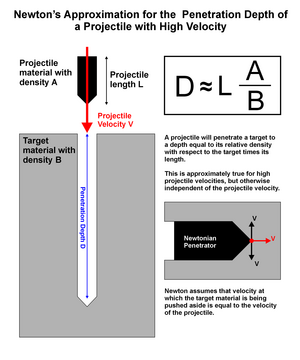Impact depth
The physicist Sir Isaac Newton first developed this idea to get rough approximations for the impact depth for projectiles travelling at high velocities.
Newton's approximation for the impact depth

Newton's approximation for the impact depth for projectiles at high velocities is based only on momentum considerations. Nothing is said about where the impactor's kinetic energy goes, nor what happens to the momentum after the projectile is stopped. It gives a similar result to Hunt's Impact Theorem, but is less precise.
The basic idea is simple: The impactor carries a given momentum. To stop the impactor, this momentum must be transferred onto another mass. Since the impactor's velocity is so high that cohesion within the target material can be neglected, the momentum can only be transferred to the material (mass) directly in front of the impactor, which will be pushed at the impactor's speed. If the impactor has pushed a mass equal to its own mass at his speed, his whole momentum has been transferred to the mass in front of it and the impactor will be stopped. For a cylindrical impactor, by the time it stops, it will have penetrated to a depth that is equal to its own length times its relative density with respect to the target material.
This approach only holds for a blunt impactor (no aerodynamical shape) and a target material with no fibres (no cohesion), at least not at the impactor's speed. This is usually true if the impactor's speed is much higher than the speed of sound within the target material. At high velocities like that, most materials start to behave like a fluid. It is then important that the projectile stays in a compact shape during impact (no spreading).
Applications
- Projectile: Full metal projectiles should be made of a material with a very high density, like uranium (19.1 g/cm³) or lead (11.3 g/cm³). According to Newton's approximation, a full metal projectile made of uranium will pierce through roughly 2.5 times its own length of steel armor.
- Shaped charge, Bazooka: For a shaped charge (anti-tank) to pierce through steel plates, it is essential that the explosion generates a long heavy metal jet (in a shaped charge for anti-tank use, the explosion generates a high speed metal jet from the cone shaped metal lining). This jet may then be viewed as the impactor of Newton's approximation.
- Meteorite: As may be concluded from the air pressure, the atmosphere's material is equivalent to about 10 m of water. Since ice has about the same density as water, an ice cube from space travelling at 15 km/s or so must have a length of 10 m to reach the surface of the earth at high speed. A smaller ice cube will be stopped in mid-air and explode. An ice cube with a diameter of 50 m or more, however, may also be stopped in mid-air, as long as it comes in at a very low angle and thus has to pierce through a lot of atmosphere. The Tunguska event is sometimes explained this way. An iron meteorite with a length of 1.3 m would punch through the atmosphere, a smaller one would be stopped in the air and drop down by the gravitational pull. The Black Stone, for example, with a diameter of 0.5 m would fit into this category.
- Impactor, Bunker buster: Solid impactors can be used instead of nuclear warheads to penetrate bunkers. According to Newton's approximation, a uranium projectile at high speed and 1 m in length would punch its way through 6 m of rock (density 3 g/cm³) before coming to a stop. Such an impactor, at a speed of 5 to 15 km/s, carries more kinetic energy than an explosive warhead of the same mass carries explosive energy.
